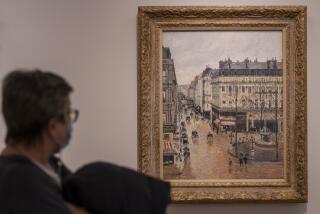Germany: Nazi stolen-art trove may be largest found in private hands
LONDON -- A $1.3-billion trove of art, some or all of which was looted by the Nazis more than 70 years ago, appears to be without parallel in the annals of stolen art, experts say.
“It is the largest cache held by a private individual illegally by miles,” Julian Radcliffe, chairman of the Art Loss Register in London, which tracks vanished works of art, said Monday. “Two years ago we found a dealer who had two stolen pictures in his safe when he died, and we thought that was pretty shocking because he had actually been put in jail by the French in 1946 for being part of the Holocaust looting. … To find one on this scale is exceptional.”
More than 1,500 pieces of priceless art by such artists as Picasso, Chagall, Matisse and Klee were found crammed next to piles of canned food in a messy apartment in Munich, Germany, in early 2011. The find did not become public until an article about it was published this week in the German news magazine Focus (link in German).
The apartment belonged to Cornelius Gurlitt, the 80-year-old son of a well-known Nazi-era art dealer.
German officials kept mum about the raid on Gurlitt’s home as they moved the art into safe storage outside Munich and started untangling the tricky knot of issues surrounding their provenance and whether -- and how -- to return them to their rightful owners.
Many of those original owners could turn out to be Jewish families who saw their belongings confiscated by the Nazis or who sold them at knock-down prices in their desperation to flee Europe and avoid deportation to the extermination camps.
That the authorities in Bavaria, in southern Germany, took so long to acknowledge their astounding discovery and have yet to publish an inventory disturbs some advocates of reuniting stolen art with their proper owners.
“It doesn’t take two-and-three-quarters years to do that,” said Anne Webber, co-chair of the Commission for Looted Art in Europe, a nonprofit organization. “There’s a complete lack of transparency about this. Families have been looking for [their] art for 75 years.”
Focus reported that 200 of the works taken from Gurlitt’s home had international warrants on them. The German government said Monday that it was helping Bavarian officials with their investigation. Prosecutors could reveal more details in a media briefing Tuesday.
Focus said that Gurlitt sold off individual pieces when he needed money. In one instance, the circumstances of which remain unclear, he was able to put a painting by German Expressionist Max Beckmann up for sale at an auction months after his apartment had been raided.
“The Lion Tamer” was not listed in the Art Loss Register’s database. Heirs of the original owner somehow got wind of the auction, claimed the painting as theirs and reached a settlement with the auction house, which proceeded with the sale, Webber said. The work fetched nearly $1.2 million.
“What would have happened if the family had not identified it?” Webber asked.
Gurlitt’s father, Hildebrand, was a knowledgeable art dealer whom the Nazis tapped, despite some suspicion about his suitability and background, to help them collect and dispose of artworks, including those taken forcibly from Jews. Many of the pieces the elder Gurlitt acquired or handled were believed destroyed during bombing.
“At the end of the war he was interrogated by the Allies and asked what he had. He was reputed to have a truckload of art, and he said, ‘It’s all rumors, all of it was destroyed, I just have a few paintings from my dead father and my sister,’” Webber said. “Many of these dealers, these people who … worked with the Nazis dealing and trading in looted art, were able to amass big collections for themselves.”
Overall, the Nazis are suspected of plundering an estimated 650,000 paintings plus an untold number of other artworks.
“This is a large cache of pictures, but it is a tiny proportion of the total we’re still looking for and a tiny proportion of the total that was taken. If you include not just the pictures that were taken from Jewish families but pictures taken from museums in Russia and so forth, there’s a huge volume,” Radcliffe said.
ALSO:
Iran: Thousands rally against U.S. on hostage anniversary
India set to launch Mars mission, provoking criticism over cost
Kenya mall attack: Four Somalis charged with aiding deadly assault
More to Read
Sign up for Essential California
The most important California stories and recommendations in your inbox every morning.
You may occasionally receive promotional content from the Los Angeles Times.










